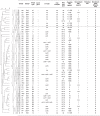Staphylococcus hominis subspecies can be identified by SDS-PAGE or MALDI-TOF MS profiles
- PMID: 31409863
- PMCID: PMC6692339
- DOI: 10.1038/s41598-019-48248-4
Staphylococcus hominis subspecies can be identified by SDS-PAGE or MALDI-TOF MS profiles
Abstract
Staphylococcus hominis is part of the normal human microbiome. Two subspecies, S. hominis hominis (Shh) and S. hominis novobiosepticus (Shn), have clinical significance. Forty-nine S. hominis isolates were analyzed by the MicroScan automated system, SDS-PAGE and MALDI-TOF methods, followed by partial sequencing of the 16S rDNA gene. The trehalose fermentation test, disk diffusion and broth microdilution tests were used to identify (novobiocin test) and access the susceptibility to oxacillin and vancomycin of isolates. The SCCmec elements and genomic diversity were evaluated by PCR and PFGE methods, respectively. Profiles of 28 (57%; 8 Shh and 20 Shn) isolates corroborated with the results found in all the applied methods of identification. The remaining 21 (43%) isolates were phenotypically identified as Shh by MicroScan; however, they were identified as Shn by SDS-PAGE and mass spectral, and confirmed by 16S rDNA sequencing. Among 41 isolates identified as Shn by the molecular and mass spectrometry methods, 19 (41%) were novobiocin-sensitive, and the trehalose test indicated 11 positive isolates, which are considered atypical phenotypic results for this subspecies. In addition, 92.7% of the isolates identified as Shn by these methods carried mecA gene, while only 12.5% of the Shh isolates were positive. Together, the results highlighted the SDS-PAGE and MALDI-TOF MS methods as promising tools for discriminating S. hominis subspecies.
Conflict of interest statement
The authors declare no competing interests.
Figures


Similar articles
-
Rapid methicillin resistance detection and subspecies discrimination in Staphylococcus hominis clinical isolates by MALDI-TOF MS.Indian J Med Microbiol. 2023 Jan-Feb;41:83-89. doi: 10.1016/j.ijmmb.2022.08.008. Epub 2022 Sep 17. Indian J Med Microbiol. 2023. PMID: 36123270
-
Reliable identification of clinically prevalent species and subspecies of staphylococci by sodium dodecyl sulfate polyacrylamide gel electrophoresis analysis.Diagn Microbiol Infect Dis. 2009 May;64(1):1-5. doi: 10.1016/j.diagmicrobio.2008.12.017. Diagn Microbiol Infect Dis. 2009. PMID: 19362254
-
Multilocus sequence typing and further genetic characterization of the enigmatic pathogen, Staphylococcus hominis.PLoS One. 2013 Jun 11;8(6):e66496. doi: 10.1371/journal.pone.0066496. Print 2013. PLoS One. 2013. PMID: 23776678 Free PMC article.
-
Antibiotic Susceptibility of Biofilm Cells and Molecular Characterisation of Staphylococcus hominis Isolates from Blood.PLoS One. 2015 Dec 14;10(12):e0144684. doi: 10.1371/journal.pone.0144684. eCollection 2015. PLoS One. 2015. PMID: 26659110 Free PMC article.
-
A sequence variant of Staphylococcus hominis with a high prevalence of oxacillin and fluoroquinolone resistance.Res Microbiol. 2001 Nov;152(9):805-10. doi: 10.1016/s0923-2508(01)01264-5. Res Microbiol. 2001. PMID: 11763241
Cited by
-
Laboratory Diagnostic Methods and Antibiotic Resistance Patterns of Staphylococcus aureus and Escherichia coli Strains: An Evolving Human Health Challenge.Diagnostics (Basel). 2022 Oct 31;12(11):2645. doi: 10.3390/diagnostics12112645. Diagnostics (Basel). 2022. PMID: 36359489 Free PMC article.
-
Time to positive culture can differentiate post-neurosurgical coagulase-negative Staphylococci other than S epidermidis meningitis from contamination: A case-control observational study.J Clin Lab Anal. 2020 Oct;34(10):e23447. doi: 10.1002/jcla.23447. Epub 2020 Jul 7. J Clin Lab Anal. 2020. PMID: 32638442 Free PMC article.
-
Incidence, Prophylaxis and Prognosis of Acute Postoperative Endophthalmitis After Cataract Surgery: A Multicenter Retrospective Analysis in Northern China from 2013 to 2019.Infect Drug Resist. 2022 Jul 27;15:4047-4058. doi: 10.2147/IDR.S332997. eCollection 2022. Infect Drug Resist. 2022. PMID: 35924017 Free PMC article.
-
Exploring Peri-Implantitis Risk-Factors: A Cross-Sectional Study.Dent J (Basel). 2025 Mar 28;13(4):148. doi: 10.3390/dj13040148. Dent J (Basel). 2025. PMID: 40277478 Free PMC article.
References
Publication types
MeSH terms
Substances
LinkOut - more resources
Full Text Sources
Molecular Biology Databases

